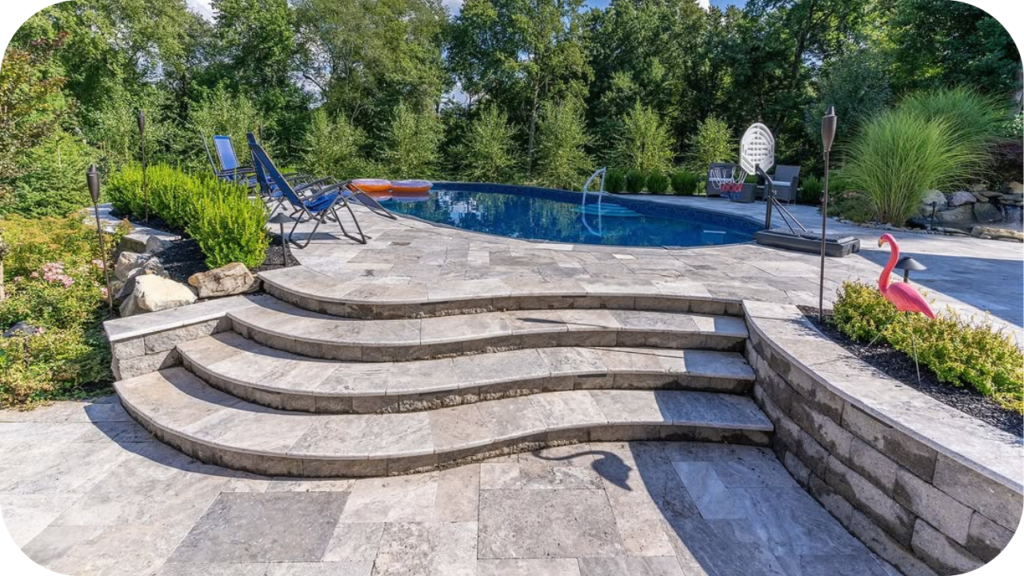
Travertine tiles remain a popular choice for outdoor landscaping thanks to their balance of natural elegance, durability, and adaptability.
Formed over centuries, each tile carries distinctive tones and textures that add depth and warmth to patios, pool surrounds, pathways, and courtyards. Their resilience allows them to handle high-traffic areas and weather extremes while maintaining their charm.
Travertine also offers a variety of finishes and colours, making it easy to complement different design styles. Below are the key advantages of using travertine tiles in landscaping projects.
1. Delivers a Timeless and Elegant Look
Travertine’s natural patterns and warm, earthy tones create a sense of timelessness that suits many outdoor styles. Whether paired with rustic landscaping or sleek modern architecture, it adds instant sophistication without feeling overstated.
Its neutral shades work well alongside greenery, timber, or other stone elements, making it a versatile backdrop for various design schemes. Over time, the surface develops a gentle patina that enhances its character, ensuring your outdoor space continues to look inviting and refined for years.
2. Withstands the Demands of Outdoor Use
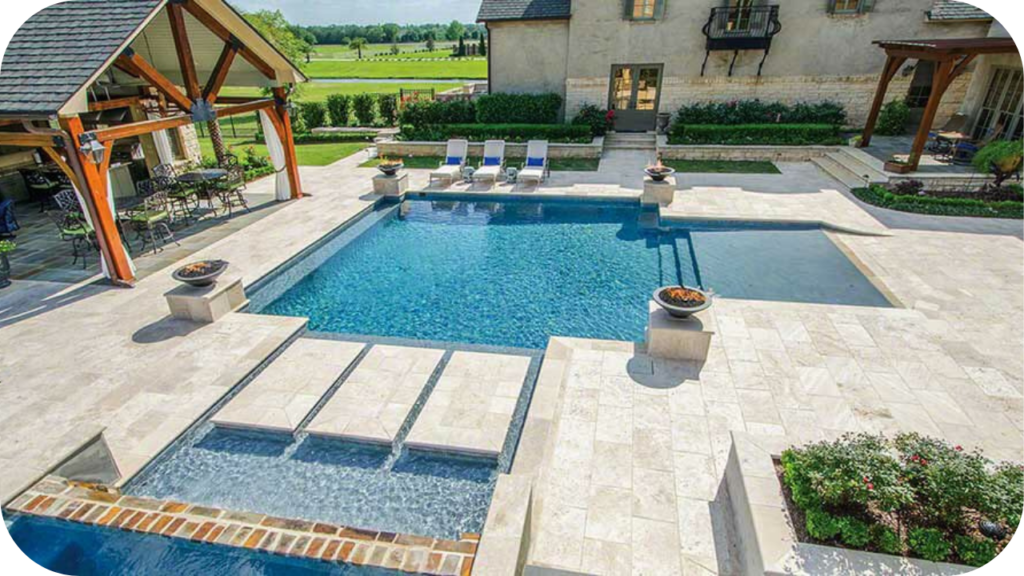
Durability is one of travertine’s strongest qualities. This stone resists chipping, cracking, and general wear, even in areas exposed to frequent use. Whether laid in a busy driveway or along a garden path, it holds up under pressure while keeping its appearance intact.
Its ability to handle temperature fluctuations means it performs well in both hot and cold climates. This resilience makes it a reliable long-term choice for landscaping projects that demand both beauty and lasting strength.
3. Provides a Safer Walking Surface
Safety is a priority in outdoor areas, and travertine’s natural texture offers secure footing even when conditions are wet. This makes it ideal for spaces such as pool surrounds, garden steps, or pathways where water may be present.
The stone’s surface adds a comfortable tactile feel underfoot while helping to prevent accidental falls. With this combination of practicality and elegance, homeowners can create outdoor areas that feel both inviting and reassuring to walk on in all seasons.
4. Stays Cool Under Direct Sunlight
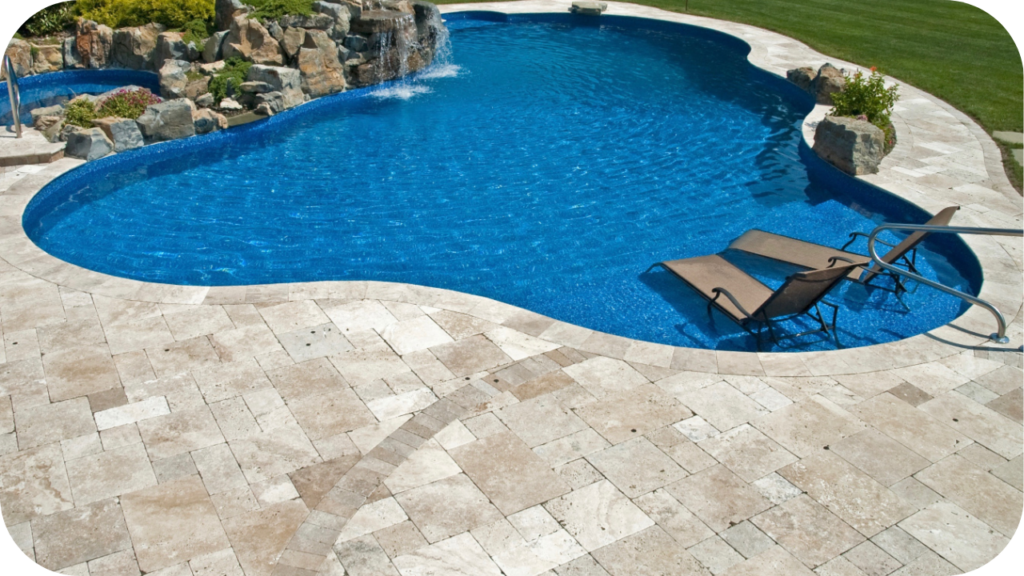
Walking barefoot on scorching paving can be uncomfortable, but travertine offers a cooler surface thanks to its natural thermal properties. Even in the peak of summer, it remains pleasant underfoot, making it ideal for pool surrounds, patios, and terraces.
This comfort factor adds to the enjoyment of outdoor living spaces, especially in warm climates. By staying cool while looking attractive, travertine helps create areas that are practical as well as visually inviting for daily use.
5. Offers Multiple Design Possibilities
From tumbled to honed or brushed, travertine comes in finishes that suit different design intentions. It can be cut into a variety of sizes, allowing for layouts like French pattern, straight lay, or herringbone.
This flexibility means you can tailor the look to suit your property’s style, whether you want a relaxed, rustic atmosphere or a clean, contemporary feel. The stone’s variety ensures each installation feels unique while still maintaining the classic appeal travertine is known for.
6. Creates Seamless Indoor-Outdoor Transitions
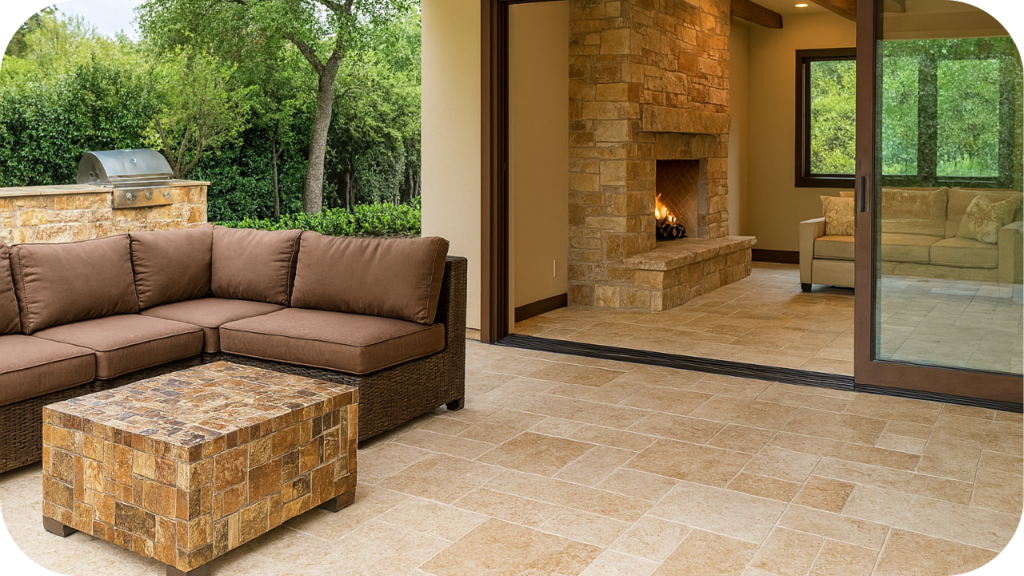
Extending travertine from indoor living areas to outdoor spaces creates a cohesive, flowing design. This approach enhances the feeling of openness and makes smaller properties feel more expansive.
Using the same tile indoors and out also unifies the colour palette and texture across your home. It’s a simple yet effective way to connect spaces visually and functionally, giving your property a polished and considered finish that works for both everyday living and entertaining.
7. Requires Minimal Maintenance
For homeowners who value low-maintenance materials, travertine is a practical choice. Once sealed, it resists staining and can be cleaned with just mild soap and water. Its durability means it doesn’t require constant upkeep to stay looking good.
Regular sweeping and occasional resealing are usually enough to maintain its beauty. This balance of visual appeal and easy care makes travertine ideal for busy households that still want outdoor spaces to feel well-kept and stylish.
8. Supports Sustainable Landscaping Practices
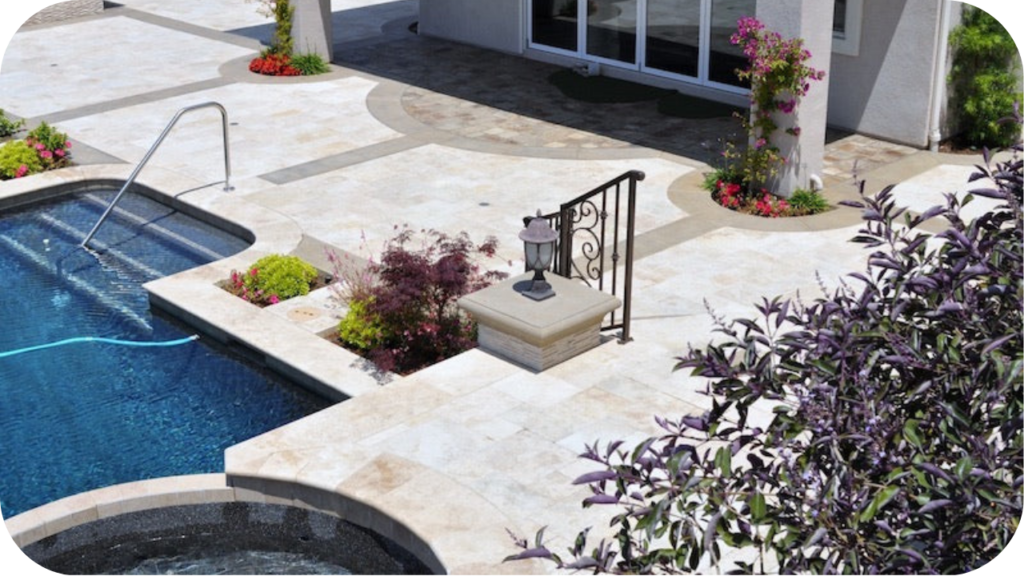
As a natural stone, travertine is recyclable and requires less processing compared to synthetic materials, reducing its environmental impact. Its longevity means fewer replacements over time, cutting down on waste and resource use.
Choosing travertine supports more sustainable construction practices without compromising on quality or appearance. For projects aiming to be eco-conscious, it offers a material that aligns with green building goals while still delivering the elegance and practicality desired in landscaping.
9. Resists Heat, Frost, and Weather Damage
Outdoor materials need to handle the elements, and travertine does this with ease. It withstands intense heat, heavy rain, and freezing temperatures without warping or deteriorating. This resilience makes it suitable for a wide range of climates and landscaping applications.
By maintaining both its structure and appearance over time, travertine ensures that your investment remains functional and attractive despite seasonal changes or extreme weather conditions.
10. Enhances Property Appeal and Value
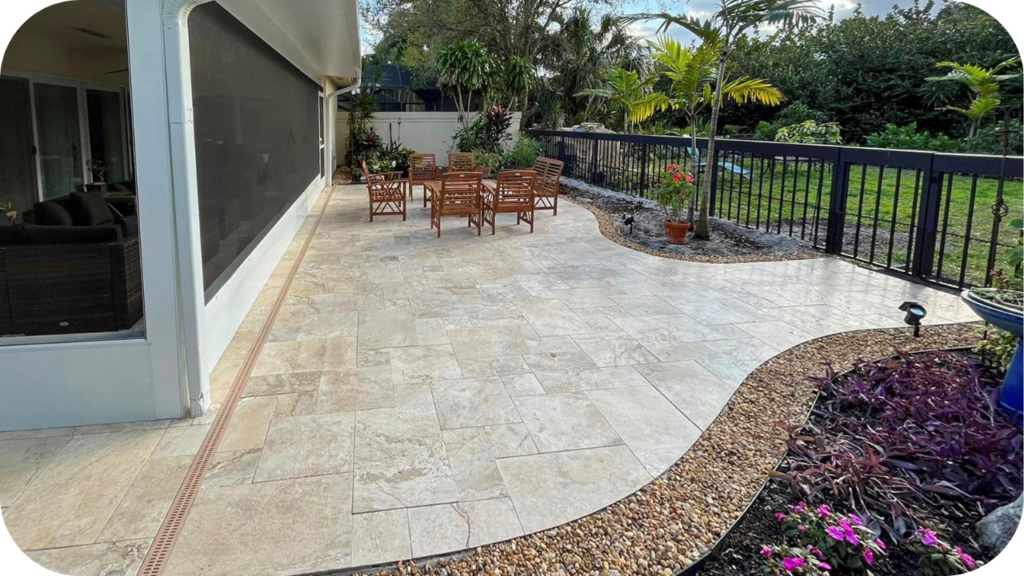
Premium landscaping materials can increase a property’s appeal, and travertine is no exception. Its high-end appearance signals quality, which can be attractive to potential buyers. Even if selling isn’t in your immediate plans, adding travertine to your landscaping can create a more enjoyable and impressive outdoor environment.
This combination of beauty, durability, and practicality adds tangible value, making it a worthwhile choice for homeowners seeking both aesthetic and financial benefits from their investment.
How to Select the Best Travertine for Landscaping
Choosing the right travertine involves more than appearance alone. These practical tips will help you select tiles that perform well and look great in your outdoor space.
1. Assess the Thickness for Durability
Choose a thickness that matches the demands of your project. Thicker tiles are ideal for high-traffic spaces such as driveways or steps, while standard paver thickness works well for patios, courtyards, and light-use garden paths.
2. Select a Finish That Matches the Application
Travertine is available in a variety of finishes such as tumbled, honed, and brushed, each offering a distinct look and feel. Consider how the finish will perform in your chosen area and complement the surrounding design elements.
3. Match the Colour to Your Outdoor Design
The right colour can set the mood for your entire outdoor space. Light tones create an open, airy feel, while darker shades bring warmth and depth. Choose colours that coordinate with plants, walls, and furniture.
4. Confirm the Quality of the Stone Source
Always buy from a reputable supplier to ensure you receive genuine, high-grade travertine. Quality sourcing reduces the risk of imperfections and ensures the tiles will perform well in outdoor conditions for many years.
5. Consider the Tile Size and Pattern Layout
The dimensions and layout pattern can significantly affect the final look. Large-format tiles create a modern, seamless feel, while smaller tiles in decorative patterns add interest and detail to the landscaping design.
Care and Maintenance Tips for Outdoor Travertine

Keeping travertine in top condition is simple with a few consistent habits. These tips will help preserve its appearance and ensure long-lasting performance in outdoor spaces.
- Seal the tiles after installation: Apply a quality sealant to protect against stains and weather damage, especially in high-use areas, and reapply as needed over time.
- Clean with mild, pH-neutral products: Use gentle cleaners and water to remove dirt and spills without harming the stone’s surface or altering its natural colour.
- Sweep regularly to remove debris: Prevent scratches and surface wear by keeping leaves, grit, and other particles off the tiles through routine sweeping or light hosing.
- Address spills immediately: Wipe up liquids quickly to reduce the risk of staining, particularly in dining or cooking areas where food and drinks are often present.
- Repair chips or cracks promptly: Fix any damage early to maintain the stone’s structural integrity and prevent issues from worsening with weather exposure or foot traffic.
Conclusion
Travertine tiles offer a rare mix of beauty, durability, and versatility, making them an excellent choice for any outdoor landscaping project. From patios and pool surrounds to driveways and courtyards, the right tiles can elevate both appearance and practicality.
Select from Splendour in Stone’s premium travertine range and let our team offer personalised advice and professional installation to ensure your paving looks exceptional and lasts for many years.
More To Explore
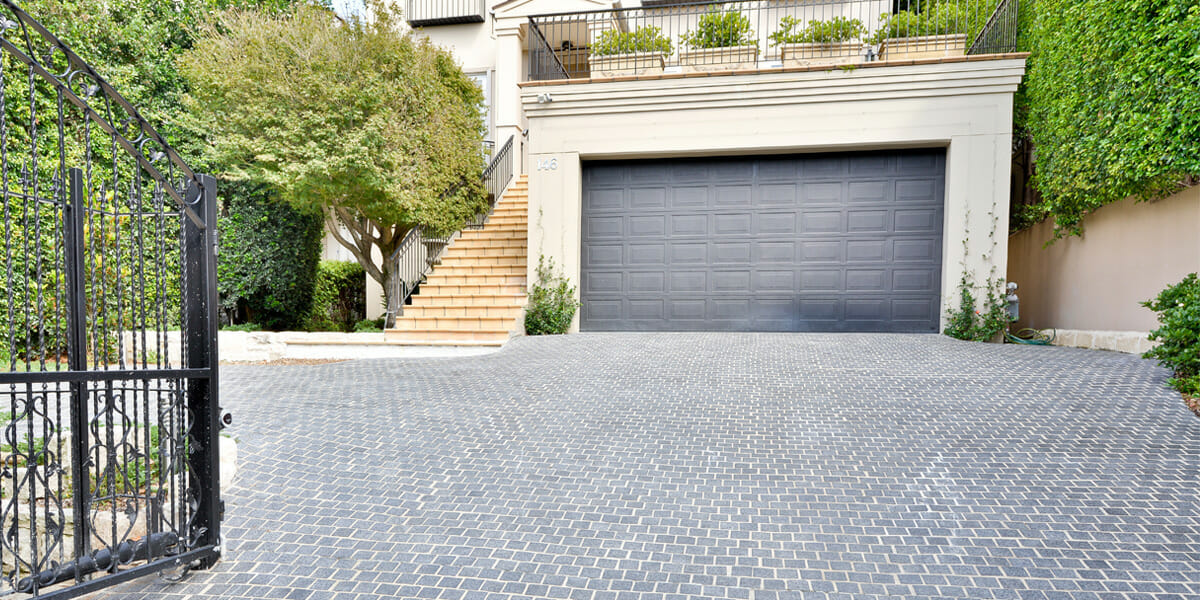
Grey Granite Cobblestones for Driveways: Strength and Style
Grey granite cobblestones combine strength, safety, and timeless appeal, making them a popular choice for Melbourne driveways and outdoor spaces. Their natural flamed texture offers
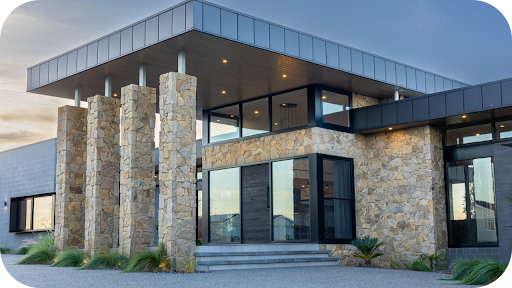
Granite Wall Cladding Melbourne: Modern and Classic Appeal
Granite wall cladding brings both modern sophistication and classic charm to Melbourne architecture. Known for its durability and natural beauty, granite transforms façades, feature walls,


